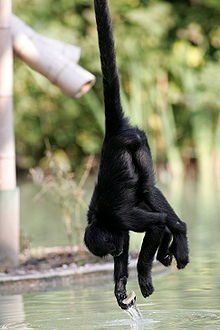Spider monkey
| Spider monkey | |
|---|---|

| |
| A black-headed spider monkey (Ateles fusciceps) using its prehensile tail. | |
| Scientific classification | |
| Kingdom: | |
| Phylum: | |
| Class: | |
| Order: | |
| Suborder: | |
| Family: | |
| Genus: | Ateles E. Geoffroy, 1806
|
Spider monkeys are New World monkeys, genus Ateles. They are small monkeys, well suited to living in trees. In fact, they rarely come down to the ground. These monkeys move quickly through trees by swinging and jumping from branch to branch.
Spider monkeys are found in rainforests in southern Mexico to the northern part of South America. Spider monkeys live in groups or bands of 10 to 40 monkeys. Every band lives in its own territory and one band of monkeys will not enter the territory of another band. Spider monkeys have one offspring per year. They live between 20 to 27 years, or more.[1][2]
Diet[change | change source]
Spider monkeys eat fruit, nuts, leaves, and small eggs. Usually the leader female of the whole group is responsible for finding and gathering all the food for the rest of the group. When there is not enough food, they sometimes eat bark, or honey, or insects.
Physical description[change | change source]
Spider monkeys are extremely quick, and they have long, thin fingers with almost no hair at all. Unlike other monkeys, they use their tail much more than their fingers, and their tails are longer than their bodies. These tails can grasp and pick things up.
They have long, spindly limbs, which explains the spider monkey's common name. Their tails are fully prehensile, meaning they can pick things up with it,[3] and they can swing from it. The tail, which may be up to 89 cm (35 in) long, is very flexible, with hairless tips and skin grooves similar to fingerprints. This adaptation to their strictly arboreal lifestyle serves as a fifth hand. They are clumsy on the ground.
References[change | change source]
- ↑ Cawthon Lang, KA (2007). "Primate Factsheets: Black spider monkey (Ateles fisciceps) Taxonomy, morphology, and ecology". Wisconsin Primate Research Center (WPRC). Retrieved May 20, 2009.
- ↑ Maurice and Robert Burton (2002). International Wildlife Encyclopedia. pp. 2477–2479. ISBN 9780761472742.
- ↑ Elizabeth P. Benson (1997). Birds and Beasts of Ancient Latin America. p. 60. ISBN 9780813015187.
